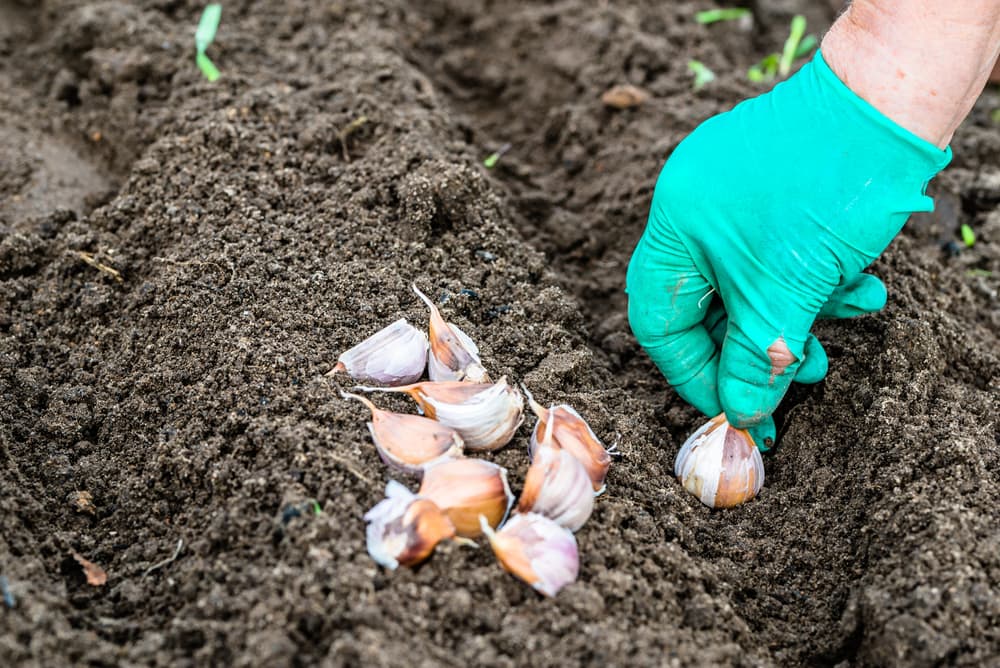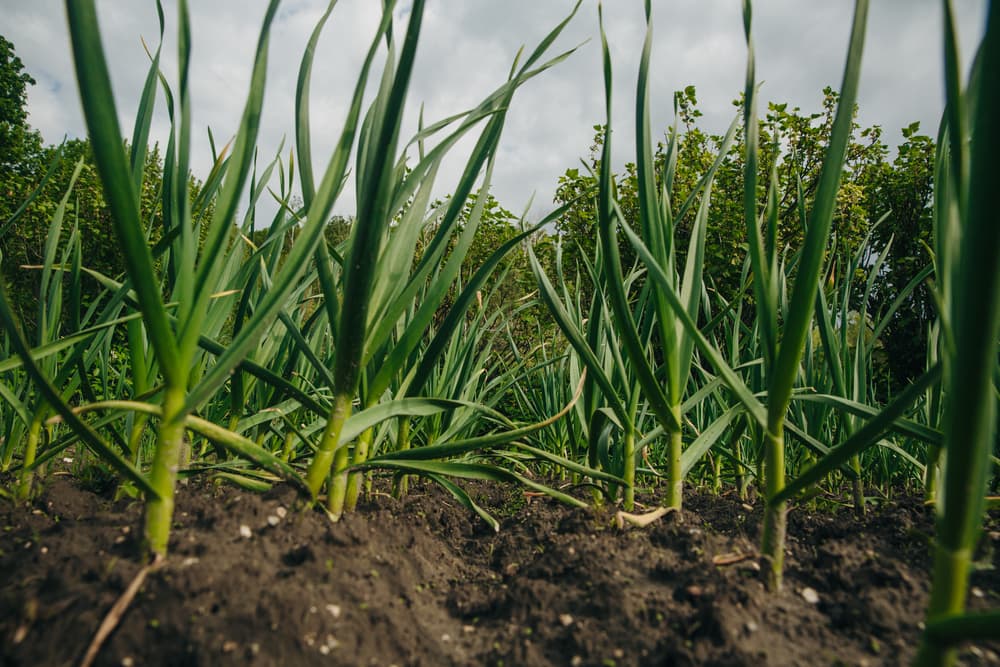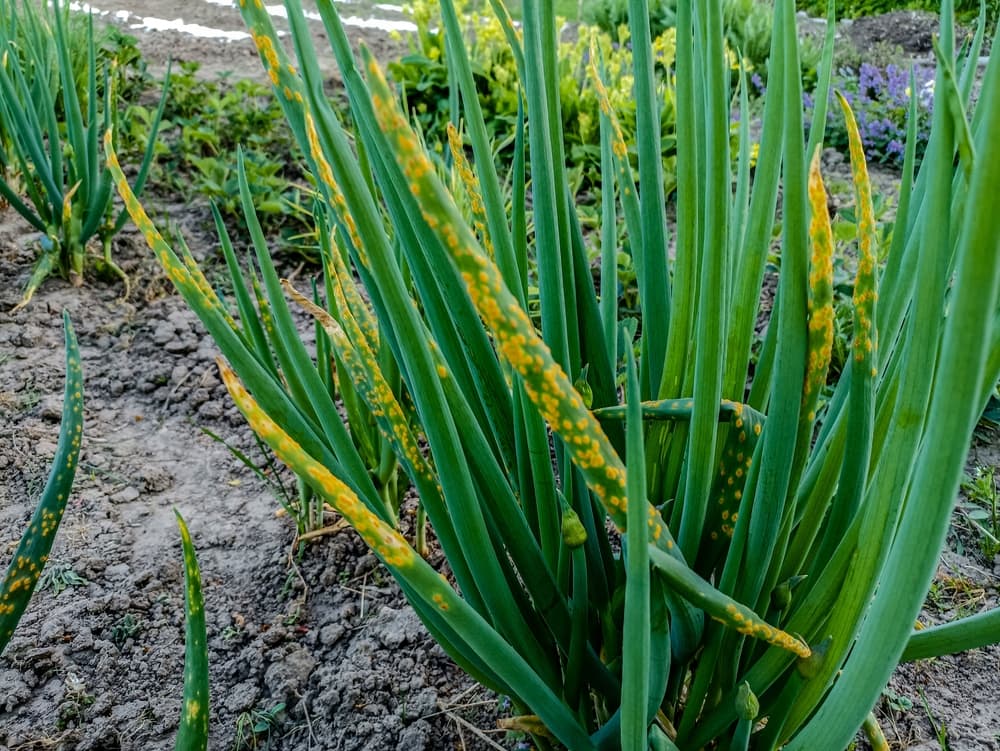BULBS > GARLIC
Chris is a gardening writer and nature enthusiast. He graduated from Oxford Brookes University in 2022 with an MA in Psychology. Chris works with the Leeds Green Action Society, helping their food cooperative by growing various fruit and vegetables on their two allotments in Hyde Park, Leeds.
Reviewed By ROY NICOL

Roy is a Professional Gardener and Horticultural Consultant, specialising in large garden year-round maintenance and garden development. He is an RHS Master of Horticulture and uses his research in the application of no-dig methods in ornamental garden settings. Roy has been a Professional Gardener for more than six years and is a member of the Chartered Institute of Horticulture, Professional Gardener's Guild and Association of Professional Landscapers (Professional Gardener).
Contributions From EMILY CUPIT

Emily is a Gardening Writer, Photographer and Videographer from Derbyshire, UK. She is the Founder of Emily's Green Diary - a community of more than 75,000 people who share in her gardening journey.
IN THIS GUIDE
GARLIC GUIDES
A native of the onion family, garlic is a popular plant for amateur gardeners to grow, due to the fact it doesn’t need a lot of nurturing.
It’s pretty hardy against pests and it provides a great ingredient for any number of recipes.
In fact, it is used for cooking pretty much the world over – and has been for centuries now – especially in the warmer Mediterranean countries, such as Southern Spain, France and Italy.1Mahr, S. (n.d.-a). Garlic, Allium sativum. Wisconsin Horticulture. Retrieved March 15, 2023, from https://hort.extension.wisc.edu/articles/garlic-allium-sativum/
Overview
| Botanical Name | Allium sativum |
| Common Name(s) | Garlic |
| Plant Type | Bulb |
| Native Area | Central Asia |
| Hardiness Rating | Varies, typically H4 |
| Foliage | Aromatic, thin leaves |
| Flowers | Edible, allium flowers |
| When To Sow | January, February, March, October, November, December |
| Flowering Months | May, June, July |
| Harvesting Months | August, September, October |
Sunlight
Preferred
Full Sun
Exposure
Exposed or Sheltered
Size
Height
0.1 – 0.5M
Spread
0 – 0.1M
Bloom Time
Late Spring
Soil
Preferred
Most Soil Types
Moisture
Moist but well drained
pH
Alkaline or neutral
“One of the best plants I grow in my vegetable garden is garlic,” shares Kate Cotterill, Garden Designer.
“I don’t have a massive vegetable garden, but I grow enough garlic to sustain us for an entire year, which is great because I use a lot of it.”
Garlic cloves are best bought from a gardening centre or nursery, rather than a supermarket, because:
- The supermarket variety may have been grown abroad and therefore unsuitable for a UK climate.
- Also, you don’t know if the soil in which it grew was infected with diseases such as onion white rot or leek rust, which affect garlic.
- Thirdly, the supermarket variety will likely have been subjected to chemical sprays, such as growth inhibitors.
Note that garlic shouldn’t be grown in the same place a garlic crop, onions or leeks have previously been grown – at least, not for another two years.
Also, the spot in which you do choose to grow it should be covered with netting to deter birds from getting at the early bulbs.
Garlic Types
Elephant Garlic

“I grow a variety of elephant garlic that is massive and has huge cloves that we absolutely love in my family,” shares Kate.
As its name implies, this type of garlic needs spacing out in the soil for its roots to flourish.
Wild Garlic

Bulbs shouldn’t be lifted in the first year in order to allow the plant to spread its seed heads wider and multiply the crop.
“Wild garlic is a woodland plant that requires shade to grow well and it’s grown for its leaves as well as the bulb,” shares Master Horticulturist Roy Nicol.
“Care should be taken with allowing the seed to spread as this plant can be invasive.”
Rocamboles

A form of hardneck garlic which is terrific for cooking with.
Pull off the floral spikes as soon as they appear (softneck varieties of garlic don’t produce a spike and you’ll get more cloves per bulb as a result).
How To Grow & Plant Garlic
Choose a spot in your garden that is guaranteed to receive the most sunshine then mix the soil there with a good compost (do this several weeks before you start the actual planting to give it time to blend well).
The day before you intend to plant your garlic bulbs, break them up.
Next day plant them up to 4cm deep in the soil, 15cm apart, with the flat root plate facing downwards (and therefore the pointed end upwards).
When To Plant
The best time to plant your garlic bulbs is in the autumn (around the third week in November).
You can also try growing your garlic indoors in pots around this time, as gardener Mollie Brown shares in this quick video:

That’s because the cloves will benefit from the initial cold weather; helping them split and form properly by the beginning of the year.
Garlic Plant Care
As the garlic grows it will need water if the soil appears too dry.
Otherwise, thanks to the rainy UK climate, it should do well on its own.
Do remove weeds though and, at the beginning of the year, add some nutrients in the form of sulphate of potash.
Luckily, even if you don’t have a garden, it’s still possible to grow this delicious vegetable.

Take 6 bulbs, for instance, and plant them in a deep, 8-inch garden pot or container.
As long as the plants are regularly watered they will do just fine sitting outside on a window ledge.
Harvesting
It’s important to get the time of harvesting right.
Having said that, it’s not too difficult to get wrong since the garlic plant itself will tell you when it’s ready to be attended to.
Certainly, do it too late and you’ll be confronted with a rotten bulb when you start digging up; too early and you’ll have missed the best bit.

It’s not only the bulbs you can eat from garlic plants; the leaves can also work in a salad, or use them as a garnish.
Hardneck garlic indicates it is ready to be lifted when the bottom leaves become a yellow or brownish colour. This is usually from May to July.
Softneck varieties of garlic should be lifted when the leaves turn yellow and begin to fall off (here you’re looking at from May to August).
Once you’ve decided it is time to go ahead and dig out the bulbs, always tread carefully, and with a gardening fork.
“I love growing garlic because it’s a crop that is usually ready in May or June, so I can harvest them then pop something else in its place very quickly, making the most out of the space,” shares Kate
After harvesting, dry them out in an airy shed by laying them on a tray or sheet.
Then store them in a dry place with a temperature of between 5-10°C.

Common Problems
Onion White Rot
This is a fungus which, if introduced to the soil, attacks the roots and bulb beneath the ground.
It is indicated on the surface by the leaves wilting and turning yellow on the surface.
Later you’ll spot a white cotton wool-like fungus on the bulb’s base and the small round black dots.
The only way to avoid this is to plant in soil where there is no existing onion rot.
Be careful though – the disease can be carried on tools, boots and other equipment and spreads very easily.
“Once the onion white rot fungus is present in the soil, crops in the allium family such as onions, leeks and garlic cannot be grown in the same soil for a period of at least seven years as there is no treatment available to domestic gardeners,” shares Roy.
“This fungus can be introduced by onion sets or garlic bulbs not bought from trusted sources, so it’s, therefore, best to grow onion and leek from seed and avoid planting supermarket garlic bulbs.”
Leek Rust
Another fungus which, this time, shows up on the leaves in the form of bright yellow spots.

It’s not as serious as onion rot and if you root out the affected plant the other bulbs should survive fine (provided you keep an eye on them).
Over-crowding can make leek rust worse because as well as making the disease easier to spread, it also causes humidity – making it more likely in the first place.
“Excess nitrogen fertiliser can encourage leek rust, so feeding applications should be balanced,” adds Roy.
“Certain varieties may have resistance and can be chosen to avoid this disease.”
FAQs
How Deep Should Bulbs Be Planted?
Garlic cloves should be planted 4cm deep into the soil and ideally between 15cm apart to give the roots enough space to expand.

The rows should be spaced every 30cm; when planting, the pointed end of the clove should point upwards.
How Tall Does Garlic Grow?
You can expect your garlic cloves to grow up to 10 inches tall at their peak.
How Long Does It Take For Garlic To Grow?
Garlic takes around 9 months to grow in conditions where, ideally, it is receiving around 6 hours of sunlight a day.
References
- 1Mahr, S. (n.d.-a). Garlic, Allium sativum. Wisconsin Horticulture. Retrieved March 15, 2023, from https://hort.extension.wisc.edu/articles/garlic-allium-sativum/


